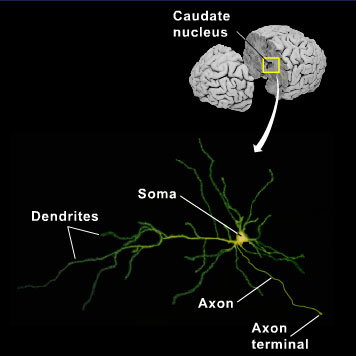Neurons are the principal cells of the brain; they comprise a cell body (or soma), dendrites and an axon that ends at a terminal (see Figure 1). The cell body contains the nucleus where DNA resides along with the nuclear machinery to direct the synthesis of proteins. The cell body is also the part of the cell in which an electrical impulse is generated. The dendrites form a branching structure off of the cell body and act as receivers. Neurotransmitters and drugs1 bind to receptors2 on dendrites that trigger membrane currents to promote or inhibit the electrical impulse generated in the cell body. The electrical impulse travels down the axon to the terminal where neurotransmitters are synthesized, stored and then released.
Figure 1 A real neuron filled with a yellow dye shows its structure. A major group of neurons that contain dopamine send their axons into the caudate nucleus, an area of the brain involved in emotion and movement.
Neurons synthesize specific chemicals called neurotransmitters. These neurotransmitters are stored in small sacs, or vesicles, in the axon terminal and they are released from the terminal following the arrival of an electrical impulse. For example, dopamine3 neurons synthesize dopamine by a series of enzymatic reactions that takes place in the neuron terminal. When an electrical impulse originating in the cell body travels down the axon to the terminal, it triggers the release of dopamine from the vesicles into the space between neurons (the synapse4) (Figure 2). Dopamine binds to dopamine receptors on neighboring dendrites to alter membrane currents. After it binds to dopamine receptors, the dopamine comes off, an can then bind to proteins (called transporters) on the releasing neuron to be taken back up into the terminal.
Figure 2 Axon terminals release dopamine into the synaptic space. Dopamine binds to dopamine receptors on the receiving neuron. Dopamine is removed from the synaptic space by transporter proteins to be returned to the terminal.
Definitions:
1 a substance that affects the structure or function of a cell or organism.
2 a protein to which hormones, neurotransmitters and drugs bind. They are usually located on cell membranes and elicit a function once bound.
3 a neurotransmitter stored in vesicles of nerve terminals; it is a monoamine that is easily oxidized. This neurotransmitter is contained in neuron pathways important in brain stimulation, addiction and control of movement.
4 the connection between two neurons; neurotransmitters are released from the terminal into the synaptic space and bind to receptors on the neighboring neuron.

